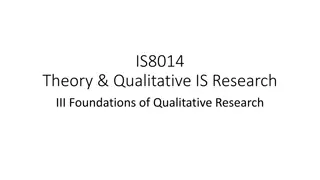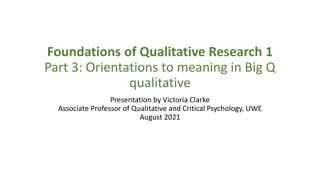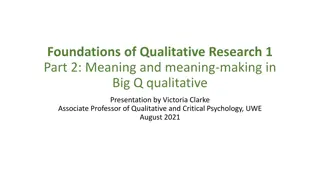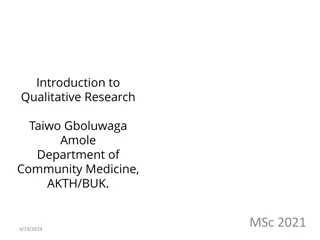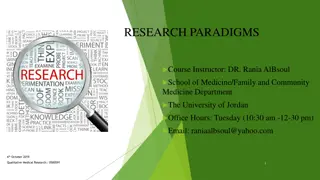Ensuring Trustworthiness in Qualitative Research Studies
Trustworthiness in qualitative research is essential for establishing confidence in the study outcomes. Guba's four criteria - credibility, transferability, dependability, and confirmability - provide a framework for achieving trustworthiness. Strategies such as adopting reliable research methods, utilizing triangulation techniques, seeking cooperation for project scrutiny, and member checking can enhance the trustworthiness of qualitative studies.
Download Presentation

Please find below an Image/Link to download the presentation.
The content on the website is provided AS IS for your information and personal use only. It may not be sold, licensed, or shared on other websites without obtaining consent from the author. Download presentation by click this link. If you encounter any issues during the download, it is possible that the publisher has removed the file from their server.
E N D
Presentation Transcript
TRUSTWORTHINESS OF THE RESEARCH
Trustworthiness: To what extent can we place confidence in the outcomes of the study? Do we believe what the researcher has reported? How can we achieve trustworthiness in qualitative studies?
Guba s (1981) four criteria: A) Credibility (instead of internal validity) B) Transferability (instead of external validity / generalizability) C) Dependability (instead of reliability) D) Confirmability (instead of objectivity)
1- CREDIBILITY Ensuring that the study is measuring or testing what is actually intended (as in internal validity) How can we ensure this? Derive the specific procedures employed (data gathering and the methods of data analysis) from those that have been successfully utilised in previous comparable projects. 1. Well-established adoption of research methods:
2. Triangulation Mainly 4 types of triangulation (Denzin, 1984) a. Data source triangulation: observing data in different context (time, space, persons) b. Investigator triangulation: multiple researchers in an investigation c. Theory triangulation: using more than one theory in the interpretation of the data (e.g. having investigators with different points of views interpret the same data) d. Methodological triangulation: using more than one method to gather data (e.g. interviews, observations, questionnaires, documents)
3. Co-operation Create opportunities for scrutiny of the project by colleagues, peers and academics get feedback at presentations (e.g. at conferences) that are given over the duration of the project.
4. member check (Lincoln and Guba, 1985) The process of asking research participants to tell you whether you have accurately described their experience. Checks may take place on the spot in the course, and at the end of the data collection dialogues. Participants may also be asked to read any transcripts of dialogues in which they have participated to check whether the participants consider that their words match with what they actually intended. Another element of member checking should involve verification of the researcher s emerging theories and inferences . Where appropriate, participants may be asked if they can offer reasons for particular patterns observed by the researcher.
2-TRANSFERABILITY (Generalizability) The extent to which the findings of one study can be applied to other situations (as in external validity) Qualitative studies do not aim to generalize the findings, Transferability is important: If other researchers believe their situations to be similar to that described in the study, they may relate the findings to their own positions, so give the Context of the Study in detail.
3-DEPENDABILITY (Reliability) Reliability: to show if the work were repeated in the same context, with the same methods and with the same participants, similar results would be obtained. For Lincoln and Guba there is a close tie between credibility and dependability: a demonstration of the credibility demonstrates its reliability Thus, give clear and detailed info about the study (thick description) The purpose of the study The sampling and setting (context of the study) Data collection and analysis procedure Findings/outcomes
4- CONFIRMABILITY (Objectivity) Ensuring as far as possible that the work s findings are the result of the experiences and ideas of the participants, rather than the characteristics and preferences of the researcher. Thus, detailed methodological description is needed




